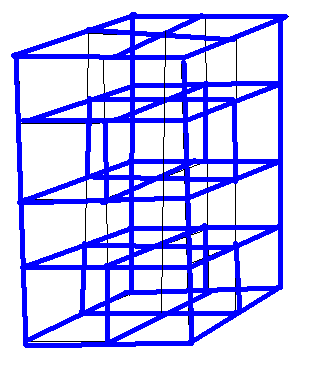Variations on Go: Including other rules, other boards, other pieces, and ways to include a third or fourth player.
Other variants
And even more variants at Sensei.
Before looking at these pages, my first thought was 3-D Go. I honestly don't know why.
The biggest problem was also obvious to me: a simple cubic board would have too many locations that each have six liberties, making capturing a veritable nightmare. I played around with the idea of using Tetrahedrons to solve this (d4's), but it didn't really work out.
I then thought about trying the cubic board, but simply eliminate some of the lines so that most of the locations still have only four liberties. Something like this:

By eliminating all of the z-axis lines, aside from those on the edge of the board, you end up with some intersections with five liberties, most with four, and corners with three. Further elimination of some lines on the faces allow us to limit any location to having only four liberties. Using this system you should choose the optimal board dimensions to have the board make structural sense (unlike my example):

Actually, if you simply play only on the faces of the cube, you end up with a close approximation of a plain Go board, with no more than four liberties from any location. While that is a step "up" from a traditional Go board, it doesn't give me the real feel of three dimensions.
(A variant for this would be to play on three nested but completely separated cubes. This would be like playing three games of Go simultaneously on three different sized boards, where you can decide on which board to move each time it is your play. While a tad more confusing, it doesn't really add anything to the experience.
Another very strange variant would be to play several dozen games of Go simultaneously, where each plane represents a different game, and a single stone is placed simultaneously on three boards.)
I then went on-line to see what had been done with 3-D Go already. There is a three dimensional Go game on Sourceforge, but it simply uses the 5x5x5 cube shape.
A more interesting approach is Diamond Go, which uses a strange crytalline latice structure in such a way that a true Go experience is recreated in three dimensions. Each location has four, three, or two liberties.

Ishihama Yoshiaki also examines several variations on three dimensional boards that produce playable experiences similar to the two dimentional version, including some really funky board shapes.
Funky.
Links:
Maksim points me to a report exploring games and health, including a game Glucoboy that helps you maintain the body's ideal blood sugar level for diabetics:
Glucoboy is a glucose meter that can be inserted into a Nintendo Gameboy. The product operates independent of the video game system but downloads video game programs that are contained within its circuitry into the Gameboy as a reward for maintaining good blood sugar control. With the patient being responsible for so much of proper diabetes management the Glucoboy carries an essential dual role, providing accurate medical diagnosis for the disease as well as an incentive delivery platform which serves as a key portal for obtaining patient-critical medical data; the foundation for fully automated, individualized, disease management program.There sure is a lot of new research going into how to marry games and health.
Speaking of games and the body, Columia University and the University of New Mexico have got DNA based computers playing and winning Tic Tac Toe.
Yehuda
Update: Bernie points to a Torus shaped Go board, no corners or sides.
1 comment:
1. I know this is coming just a bit late to the party.
2. Your system won't allow me to subscribe so this will have to be done without it.
On Disqus, I'm J4Zonian
3. I think you probably got the idea of 3-D go from the original Star Trek or a later iteration, where they play 3-D chess. I actually bought a set and played for a while.
I think space, in the far distant future (assuming we have a future) is the only place and time people could master 3-D go. I've read that it was rare for ancient masters to be able to recreate a whole go game from memory and that now it's standard for any professional player and some amateurs. Other progress and standing on the shoulders of giants means skills have advanced.
19x19 3-D go would be horrifically complex and would only be masterable by a tiny number of geniuses. Of course with a galactic population of several trillion, there would be enough geniuses for that to be a sizable club.
Post a Comment